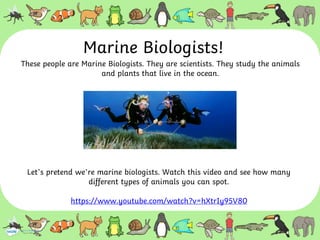
Animal types, diferent types of birds, fishes and earth animals
- 1. Marine Biologists! These people are Marine Biologists. They are scientists. They study the animals and plants that live in the ocean. Let’s pretend we’re marine biologists. Watch this video and see how many different types of animals you can spot. https://www.youtube.com/watch?v=hXtrIy95V80
- 2. Read through the slides to remind yourself about the different types of animals. On each page there is a link to a 1 minute video that you can watch about each animal type. (play this PowerPoint as a slideshow to get the links and quiz to work) Once you’ve read the information slides, there is a fun game you can play to sort the ocean and seaside animals. How many points can you get? Instructions
- 3. Basic Animal Groups There are lots of different types of animals in the world. Here are 6 groups of animals on Earth: Birds Mammals Fish Amphibians Reptiles Invertebrate Can you name an animal that fits into each animal type?
- 4. Birds • Birds have feathers. • Birds have a bill. • Most birds can fly. • Ostriches, kiwis and penguins lost their ability to fly as their lifestyles were more suited to land or water. Click here to watch a video about birds!
- 5. Fish • Fish live in water. • They have skin covered with scales. • They have two sets of fins. • They have a set of gills. Click here to watch a video about fish!
- 6. Invertebrates • Invertebrates do not have a backbone. • Some have exoskeletons, hard shells outside their body, like snails. • Some have no bones, like an octopus. • Invertebrates are animals like: insects, flatworms, squid or an octopus. Click here to watch a video about invertebrates!
- 7. Amphibians • Amphibians are animals like: frogs, toads, newts and salamanders. • They live on land but they tend to go in water a lot. Have you ever seen frogspawn? • Amphibians have moist, slimy skin. • They lay eggs. Click here to watch a video about amphibians!
- 8. Reptiles • They have dry, scaly skin. • They lay eggs with hard shells. • Reptiles are animals like turtles, crocodiles, lizards and snakes. Click here to watch a video about reptiles!
- 9. Mammals • There are lots of different types of mammals. • We are mammals. So are cows, lions, bats, whales, dogs and cats. • Some mammals live on land, e.g. dogs. • Some live in the water, e.g. whales. • Mammals have hair or fur. Click here to watch a video about mammals!
- 10. GAME! How many of these seaside and ocean animals can you sort?
- 11. fish Otter
- 13. NEXT
- 16. NEXT
- 19. NEXT Did you know: most amphibians don’t like the seaside. The water is too salty for them.
- 20. fish Sandpiper
- 22. NEXT
- 23. fish Seagull
- 25. NEXT
- 26. fish Crab
- 28. NEXT
- 29. fish Clown fish
- 31. NEXT
- 32. fish Turtle
- 34. NEXT
- 35. Blue Whale
- 37. NEXT
- 38. fish Humans
- 40. NEXT
- 41. Octopus
- 43. NEXT
- 44. THE END